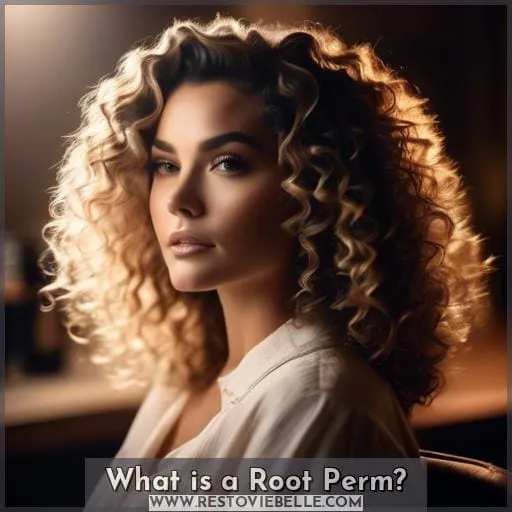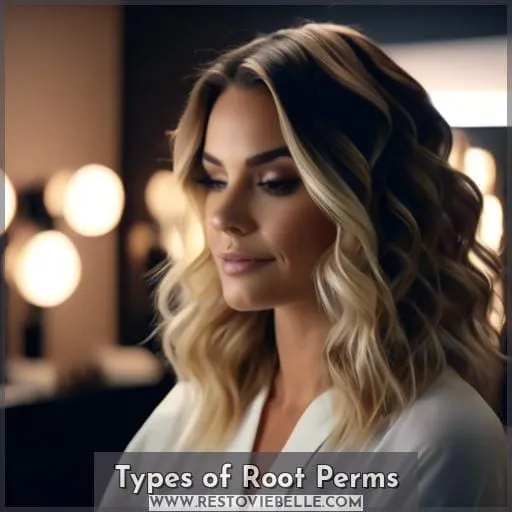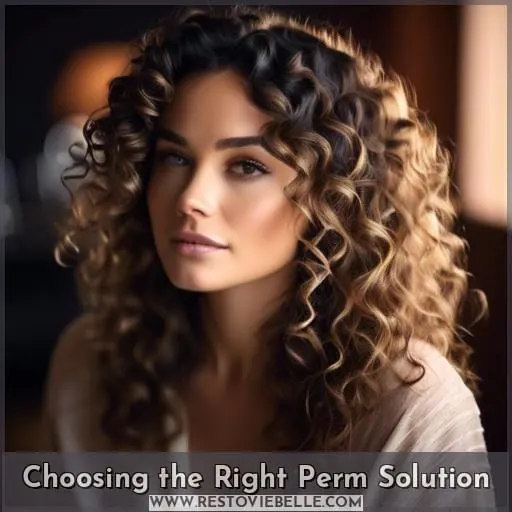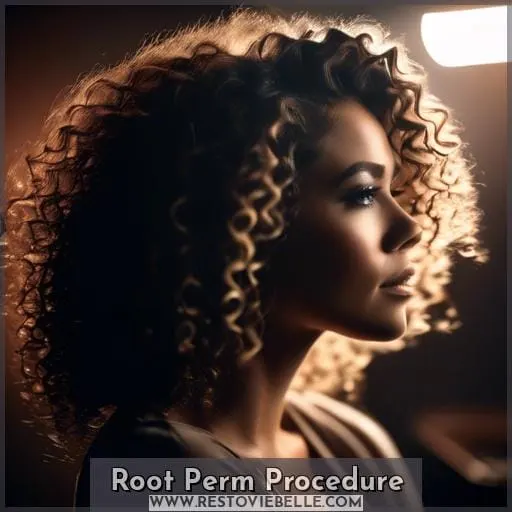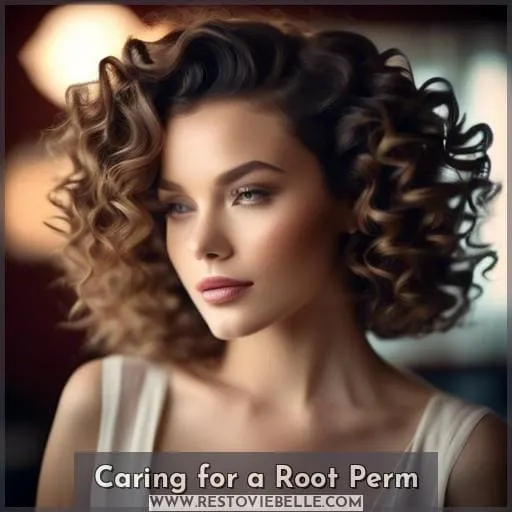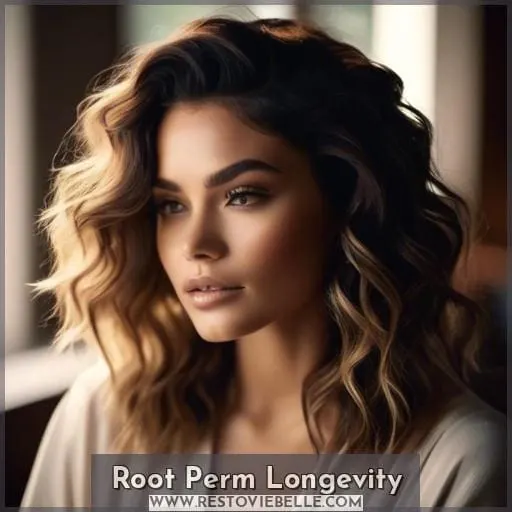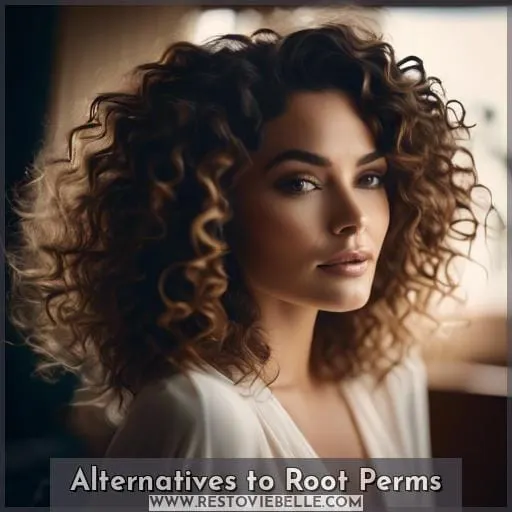This site is supported by our readers. We may earn a commission, at no cost to you, if you purchase through links.
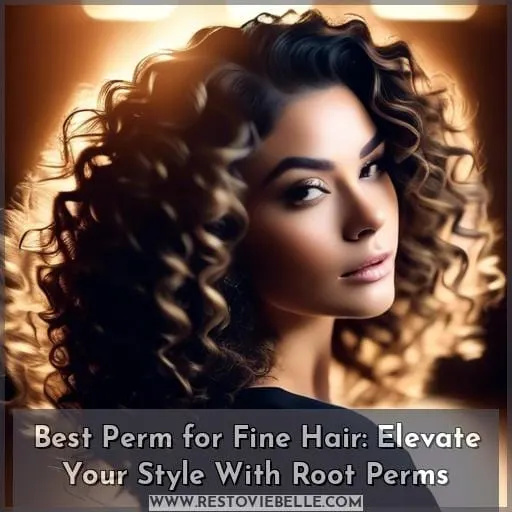 Struggling with fine hair that falls flat? Elevate your style with a root perm, the ultimate solution for adding volume and texture right from the roots.
Struggling with fine hair that falls flat? Elevate your style with a root perm, the ultimate solution for adding volume and texture right from the roots.
This specialized technique transforms your hair, giving it the lift and body you’ve been dreaming of. Whether you’re eyeing the subtle elegance of a Korean root perm or the dynamic spirals of a spiral root perm, there’s a perfect match for your hair’s unique needs.
Dive into the world of root perms and discover how to choose the right solution, care for your new look, and explore alternatives for that perfect bounce. Embrace the transformation and unlock the secrets to voluminous, lively hair that stands out.
Table Of Contents
- Key Takeaways
- What is a Root Perm?
- Types of Root Perms
- Choosing the Right Perm Solution
- Who Should Get a Root Perm?
- Root Perm Procedure
- Caring for a Root Perm
- Root Perm Longevity
- Alternatives to Root Perms
- Frequently Asked Questions (FAQs)
- How does the climate or weather in my area affect the longevity and appearance of a root perm?
- Can I switch between different perm styles over time, and what are the implications for hair health?
- What are the specific challenges and solutions for maintaining a root perm on dyed or bleached hair?
- How does the natural aging process of hair affect the results and maintenance of a root perm?
- What are the ethical and environmental considerations of getting a root perm, including the use of chemicals and waste produced?
- Conclusion
Key Takeaways
- Root perms are ideal for adding volume at the roots, especially beneficial for short to medium-length straight or thin hair.
- For fine, thin hair, acidic perm solutions are recommended as they are gentler, minimizing potential damage.
- Body wave and beach wave perms are popular choices for fine, thin hair, offering a tousled, voluminous look without overly tight curls.
- Proper care and maintenance, including avoiding wetting the hair for 48 hours post-perm and steering clear of tight hairstyles, are crucial for preserving the perm’s integrity and appearance.
What is a Root Perm?
A root perm is a chemical hair treatment designed to add volume and lift at the roots of the hair. This type of perm targets the root area, typically the first two to three inches of the hair, altering the hair shaft bonds to change the texture and shape, which can be particularly beneficial for those with fine or flat hair.
The process involves applying a chemical solution and using perm rods or curlers at the roots to achieve the desired volume and texture. Root perms can vary in technique, such as the Korean root perm, which adds subtle volume, or spiral root perms, which create thin coiled curls.
It’s important to note that root perms are best suited for healthy, virgin hair and should be avoided if the scalp or hair follicles are damaged. The procedure typically includes washing the hair, applying the perming solution to the roots, processing the hair with or without heat, rinsing, and setting with a solution to achieve the desired shape.
While DIY kits are available, professional application is recommended due to the chemical solutions used near the scalp.
Alters Hair Shaft Bonds for Texture Change
A root perm is a chemical hair treatment designed to alter the natural structure of your hair by changing the bonds within the hair shafts. This process results in a transformation of your hair’s texture, giving you a style makeover that can range from subtle volume at the roots to more defined curls.
- Chemical alteration: A root perm involves a chemical process that modifies the bonds in your hair to change its texture and shape.
- Hair texture: The treatment is particularly beneficial for those with fine hair, as it can add much-needed volume and lift at the roots.
- Bond modification: While root perms can revitalize your hair’s appearance, it’s important to be aware of the damage potential. Always consult with a professional to ensure your hair type and condition are suitable for the treatment.
Root perms can be a game-changer for fine hair, offering a style transformation that boosts volume and confidence. However, remember that chemical treatments come with a risk of damage, so it’s crucial to weigh the pros and cons and seek professional advice.
Adds Volume, Especially to Fine Hair
Root perms are a chemical hair treatment designed to alter the hair shaft bonds, changing the hair’s texture and shape to add volume, especially at the roots. This type of perm is particularly beneficial for individuals with fine hair who are looking to enhance volume and achieve a fuller look.
Root perms can vary in style, with options like the Korean root perm, which adds subtle volume, and the spiral root perm, which creates thin coiled curls. The procedure typically involves washing the hair, applying a prepping solution and rollers to the roots, processing the hair with or without heat, rinsing, and then setting the desired shape with a solution.
When considering a root perm, it’s important to ensure that the hair and scalp are healthy, as the treatment is best suited for virgin hair and may not be recommended for those with damaged scalp or hair follicles.
Consulting with a professional is crucial, as they can advise on the most suitable perm solution—acidic for thin or damaged hair and alkaline for coarse hair—and the potential risks involved.
The root perm process can take several hours to complete, and while DIY kits are available, it’s generally recommended to have the treatment done by a professional due to the chemicals involved and their proximity to the scalp.
Aftercare is important, with advice to avoid wetting the hair or styling it in tight hairstyles for at least 48 hours post-treatment. The longevity of a root perm can vary, but touch-ups are often necessary to maintain the volume enhancement.
For those with fine hair, a root perm can offer a range of benefits, including volume enhancement, improved moisture retention, and styling diversity. It allows for a perm compatibility with the individual’s hair quality, providing a tailored approach to achieving a desired look.
Types of Root Perms
When considering enhancing your fine hair with a perm, it’s essential to understand the different types available to achieve the desired volume and texture.
Among the options, the Korean Root Perm stands out for its ability to add subtle volume at the roots, making it an excellent choice for those seeking a natural lift without the need for daily styling efforts.
Similarly, the Spiral Root Perm uses curling rods to create thin, coiled curls, offering a more defined and styled appearance ideal for longer hair.
For maintaining the vitality of your perm, Perm Touch-Ups are crucial, allowing you to add curls to new growth and keep your hairstyle looking fresh.
These types of root perms cater to different preferences and hair lengths, ensuring there’s a suitable option for everyone looking to enhance their fine hair with added volume and texture.
Korean Root Perm
Dive into the world of Korean root perms, the best perm for fine hair that craves texture and volume.
- Tailored Texture: Specifically designed to boost volume at the roots, giving your hair that much-needed lift.
- Gentle Process: Ideal for fine or even bleached hair, ensuring minimal damage.
- Stylish Results: Achieve effortlessly chic perm hairstyles that scream sophistication.
Spiral Root Perm
If you’re looking to add some oomph to your hair, a spiral root perm might just be your ticket to volume and curl definition. Unlike the subtle lift of a Korean root perm, spiral root perms go full throttle, wrapping your hair around rods to create those envy-inducing coiled curls.
But before you dive in, remember that with great curls come great responsibility. You’ll want to ensure your hair is in tip-top shape to avoid any hair damage or scalp irritation. And when it comes to the perm solution, it’s not a one-size-fits-all; choose the right one for your hair type to get those permanent waves without the worry.
So, if you’re dreaming of bouncy, spiral curls that last, a spiral root perm could be your hair’s new best friend. Just be prepared for a bit of maintenance to keep those curls looking their best.
Perm Touch-Ups
Perm touch-ups are your secret weapon in the battle against flat, lifeless hair, offering a refresh without the full commitment.
They’re a savvy choice for maintaining that voluminous look with minimal risk of perm damage.
Think of them as a pit stop for your roots, ensuring your style stays in pole position without breaking the bank on perm costs or exposing your hair to excessive perm chemicals.
Choosing the Right Perm Solution
When considering a perm for fine hair, it’s crucial to choose the right perm solution to achieve the desired style without causing unnecessary damage to your hair.
For fine or thin hair, an acidic perm solution is recommended because it’s gentler and less likely to cause harm. Acidic perms work well because they have a lower pH, closer to that of your natural hair and scalp, making them a safer option for achieving curls or waves in delicate hair types.
This approach ensures that you can enjoy a new look with added volume and texture, while minimizing the risk of damaging your fine strands.
Acidic for Thin Hair
When considering a perm for your fine hair, an acidic perm solution is your best ally. It’s gentler on delicate strands, reducing the risk of perm damage and being kinder to scalp sensitivity.
Root perms with an acidic base can give your fine hair the oomph it needs without the worry, making it a smart choice for those seeking a voluminous lift.
Alkaline for Coarse Hair
If you have coarse hair and are considering a perm, it’s crucial to choose the right perm solution to avoid unnecessary damage. Alkaline perm solutions are particularly suited for your hair type. With a pH balance between 8.
2 and 9.6, these solutions, also known as cold perms, are strong enough to provide a firmer and longer-lasting curl for thicker strands.
However, it’s not just about picking the right perm solution; you also need to consider the health of your hair and scalp. Alkaline perms can be more damaging due to their higher pH, so it’s essential to ensure your hair is in good condition before proceeding.
If you have any scalp sensitivity, it’s wise to perform a patch test to prevent adverse reactions.
When it comes to perm time, remember that alkaline perms work quickly, processing in as little as 20 minutes without the need for heat. This can be a double-edged sword, as faster processing increases the risk of hair breakage if not monitored carefully.
Therefore, it’s vital to watch the process closely and follow up with proper hair care to minimize the risk of damage.
For those wary of perm damage or with hair that’s already compromised, perm alternatives such as semi-permanent curls or heat styling tools for temporary effects might be a safer bet. These methods can provide the desired look without the long-term commitment or risk of hair breakage associated with chemical perms.
In summary, if you’re considering an alkaline perm for your coarse hair, make sure to weigh all perm considerations carefully. Ensure your hair’s health is up to par, be mindful of the perm’s potential for damage, and explore perm alternatives if you have any doubts about your hair’s ability to withstand the chemical process.
Who Should Get a Root Perm?
If you’re considering a root perm, it’s important to know that it’s ideal for those with healthy, virgin hair. This type of perm isn’t recommended if you have a damaged scalp or hair, as the chemicals used can exacerbate these issues.
Root perms are designed to add volume and lift at the roots, providing a more voluminous look, especially for those with fine or flat hair. However, if your hair is already compromised by color or chemical treatments, it’s best to avoid a root perm to prevent further damage.
Always consult with a professional stylist to assess your hair’s condition and discuss the best options for achieving the desired volume and style with a root perm.
Ideal for Healthy, Virgin Hair
Root perms are designed to alter the hair shaft bonds to change the texture and shape of the hair, specifically by adding volume at the root. This type of perm is particularly beneficial for those with fine or flat hair, as it can volumize and define curls or even loosen tight curls for a more relaxed look.
There are different types of root perms, such as the Korean root perm, which adds subtle volume at the root, and the spiral root perm, which creates thin coiled curls. For those looking to maintain an existing perm texture, perm touch-ups are also an option.
The choice between acidic perm solutions, which are gentler and suitable for thin or damaged hair, and alkaline perm solutions, which are better for coarse or textured hair, is important to consider when deciding on the type of root perm.
Root perms are best suited for healthy, virgin hair. If the scalp or hair follicles are damaged, it’s advisable to avoid this treatment. Individuals with medical conditions that affect hair or skin should consult a doctor before proceeding.
Water-based or soft perms may be safer alternatives for those concerned about the potential harm of permanent solutions to the scalp and hair.
The root perm procedure typically involves washing the hair to remove debris, applying a prepping solution and rollers to the roots, processing the hair for about 20 minutes (with or without heat), rinsing to remove the prepping solution, and then adding a setting solution to set the desired shape.
For those considering a DIY root perm, it’s important to take into account the length of the hair, as shorter hair is generally easier to work with. The type of solution used should be chosen based on hair type—acidic for thin hair and alkaline for coarse hair.
While professional application is recommended due to the proximity of the chemical solution to the scalp, DIY kits are available. However, they require careful application, and the process can take anywhere from 2 to 6 hours to complete.
In summary, root perms can be a great way to add volume and texture to fine or flat hair, but it’s crucial to choose the right type of perm and solution based on individual hair and scalp health. Professional advice is recommended to ensure the best results and to minimize potential damage.
Not Recommended for Damaged Scalp/hair
If you’re considering a root perm to add volume and life to your hair, it’s essential to understand that while this treatment can transform your look, it’s not suitable for everyone.
- Scalp Health: Your scalp’s condition is paramount. If you have a damaged scalp or hair follicles, a root perm could exacerbate the issue.
- Hair Condition: Assess the health of your hair. Perms involve chemicals that can lead to hair damage and breakage, especially if your hair is already compromised.
- Medical Consultation: If you have underlying medical conditions affecting your hair or scalp, consult a doctor before proceeding with a perm.
- DIY Risks: While DIY perm kits are available, they come with risks. The chemicals are potent and can harm your scalp, so professional application is recommended.
Root Perm Procedure
If you’re considering a root perm to add volume to your fine hair, it’s important to understand the procedure.
First, your hair will be cleansed to remove any debris. Then, a prepping solution and rollers are applied to the roots, and your hair is processed, typically for about 20 minutes, which may involve heat.
After processing, your hair is rinsed to remove the prepping solution, and a setting solution is added to lock in the desired shape.
Hair Cleansing
Before diving into the root perm procedure, it’s essential to understand that this isn’t just any old hair treatment. It’s a game-changer for those with fine hair who dream of that just-stepped-out-of-a-salon look every day.
Now, let’s talk about hair cleansing, the first step in the root perm process. Imagine giving your hair a fresh start, washing away all the impurities and build-up that weigh it down. It’s like hitting the reset button on your hair’s health, preparing it for the transformation ahead.
This isn’t just a simple shampoo; it’s a meticulous preparation that ensures the perm lotion can work its magic effectively.
Think of it as laying the groundwork for a masterpiece—your stylist is the artist, and your hair is the canvas. And remember, while root perms are a fantastic way to add oomph to fine hair, it’s crucial to consider the history of other hair treatments you’ve had.
Too much chemical damage can lead to hair loss or scalp irritation, so always consult with a professional to ensure your hair is ready for another adventure.
Application of Prepping Solution and Rollers
After cleansing your hair, it’s time to get down to the nitty-gritty of a root perm. Your stylist will apply a prepping solution to your roots, carefully considering your hair’s condition. Next, rollers are selected based on the desired volume and curl tightness—roller size matters here! For fine hair, a smaller roller might be used to ensure a noticeable lift, while larger rollers might be chosen for a softer, more natural boost.
The application time is crucial; too short and you won’t get the lift you’re after, too long and you risk hair damage. Heat usage during the process can vary; some perms require it, while others don’t.
It’s a delicate balance, like cooking the perfect al dente pasta—timing is everything.
The type of perm solution used is also tailored to your hair’s needs. Acidic solutions are gentler and better suited for fine or damaged hair, while alkaline solutions are stronger and work well for coarser hair types.
It’s like choosing the right potion for a magical transformation—each ingredient must be just right for the spell to work.
As the rollers sit, they work their magic, and you can almost hear your hair thanking you for the volume boost. It’s a waiting game, but one that promises to lift not just your roots, but your spirits too.
Processing Time
When considering a root perm, it’s essential to understand the process and set realistic expectations. The processing time is a crucial phase where the magic happens, but it’s not just about sitting and waiting.
- Perm Duration: Typically, you’ll be under the spell of the perm solution for about 20 minutes. This is your moment of transformation, where straight strands begin their journey to voluminous vibrancy.
- Damage Prevention: While you’re dreaming of your soon-to-be frizzy messy bob turning into a slightly wavy hairstyle, remember that this chemical interlude is where damage prevention is key. Think of Olaplex as your hair’s guardian angel, shielding it from potential harm.
- Chemical Precautions: It’s a chemical cocktail for your hair, so precautions are a must. Whether you’re in a salon or going the DIY route, ensure you’re not playing fast and loose with the perm potions.
Cost comparison between salon and DIY options can be significant, but remember, a professional touch often comes with the peace of mind that your crown won’t turn into a chemistry experiment gone wrong.
And if you’re dreaming of perm with highlighted curls, make sure to discuss with your stylist the best approach to maintain the integrity of your hair.
Rinsing and Setting
After the root perm solution has worked its magic, it’s time for the grand finale: rinsing and setting. You’ll bid farewell to the prepping solution as your hair is thoroughly rinsed, washing away any remnants of the chemical concoction.
Next up, a setting solution enters the scene, ensuring your new-found volume is locked in place. This isn’t just a rinse-and-go situation; it’s the moment where your roots transition from flat to fabulous.
The neutralizer is the unsung hero here, setting the stage for your hair to showcase its new lift and curl size with minimal maintenance. Remember, the right perm type and solution type are pivotal for achieving the desired effect, especially when dealing with different hair lengths.
Root perms are a commitment, so make sure you’re ready for the spotlight!
Caring for a Root Perm
After getting a root perm, it’s crucial to give your hair the proper care to maintain the volume and health of your strands.
For the first 48 hours, avoid getting your hair wet or engaging in activities that cause excessive sweating.
Additionally, steer clear of tight hairstyles that could strain your roots, as this could compromise the structure of your newly permed hair.
Avoid Wetting for 48 Hours
After diving into the world of root perms, remember, your newly volumized tresses need a tad of TLC.
Steering clear of water for 48 hours isn’t just a suggestion—it’s a must to avoid a hair-raising fiasco.
This pause allows your curls to set perfectly, ensuring your leap into perm maintenance pays off with lasting volume and style without the hefty salon cost.
Steer Clear of Tight Hairstyles
After getting a root perm, it’s crucial to treat your hair gently to avoid any unnecessary stress that could lead to scalp sensitivity or hair breakage. Here’s a little nugget of wisdom: think of your newly permed hair as a delicate silk garment that needs special care.
- Avoid tight hairstyles: Tight ponytails or braids can strain your roots and potentially weaken your hair.
- Be gentle when styling: Use a wide-tooth comb to detangle without tugging, which helps prevent breakage.
- Consider temporary alternatives: If you’re itching for a change, opt for heatless styles or soft hair accessories that don’t pull on your hair.
Root Perm Longevity
When you’re looking to add some oomph to your fine hair with a root perm, you’re probably wondering just how long you can rock those voluminous roots before heading back to the salon.
- Hair Type Matters: Just like a fingerprint, your hair’s unique. A root perm can last anywhere from 1 to 6 months, depending on whether your locks are more like delicate silk or tough denim.
- Care is Key: Treat your new ‘do like a delicate flower. Avoid washing your hair for the first 48 hours to let those curls set in. The better you care for it, the longer it’ll last.
- Lifestyle Impact: If you’re a mermaid at heart and love a good swim, remember that chlorine is a perm’s nemesis. Keep your hair away from chlorinated water to prevent a curl catastrophe.
- Touch-Ups and Trims: Even the best things in life need a little upkeep. Regular salon visits for touch-ups will keep your roots looking fresh and full of life.
Alternatives to Root Perms
If you’re looking for a change but root perms aren’t quite right for you, consider semi-permanent curls or using heat styling tools for a temporary effect.
These alternatives can offer a fresh look without the commitment of a permanent perm. They’re perfect for experimenting with different styles and finding what works best for your fine hair.
Semi-permanent Curls
If you’re considering a perm to add some oomph to your fine hair, you’re in luck—root perms are a fantastic way to elevate your style. They work by altering the hair shaft bonds to change the texture and shape, giving you that much-desired volume, especially at the roots.
But if you’re not ready to commit to a permanent change or you’re wary of potential damage, semi-permanent curls are a great alternative.
Semi-permanent curls can give you a similar effect to a root perm without the long-term commitment. They’re perfect for those who love to switch up their look or for those who want to avoid the potential heat damage associated with permanent solutions.
Here’s a quick guide to help you decide which curling method might suit your hair type and desired look:
| Type of Curl | Hair Type | Ideal For |
|---|---|---|
| Semi-permanent curls | Any type | Temporary change |
| Heatless curlers | Any type | Avoiding heat damage |
| Curling irons | Any type | Specific curl sizes |
Whether you’re after a curly hair perm, a wavy hair perm, or just some long loose waves, semi-permanent options can offer a versatile and less damaging route. And for those with short hair, don’t worry—there are short hair perm solutions that can work for you too.
Just remember, the key to a great hairstyle isn’t just the method you choose, but also taking care of your locks before and after styling. Keep your hair in tip-top shape, and you’ll be sure to turn heads with your fabulous curls, no matter which route you take.
Heat Styling Tools for Temporary Effect
For those nights when you’re dreaming of bouncy curls without the commitment, heat styling tools are your secret weapon.
Quick and versatile, they can whip up everything from beachy waves to tight spirals faster than you can say hot perm.
Just remember, while they’re great for a temporary bob or spiral perm, overuse can lead to hair damage.
Frequently Asked Questions (FAQs)
How does the climate or weather in my area affect the longevity and appearance of a root perm?
Humidity and heat are like kryptonite to your root perm, potentially turning your voluminous dreams into a frizzy nightmare.
On the flip side, dry climates might just be your perm’s best friend, keeping those roots lifted and your hair game strong.
Can I switch between different perm styles over time, and what are the implications for hair health?
Switching between different perm styles over time can be a playful parade of personal expression, but it’s not without its pitfalls for your precious locks.
Each perm involves a chemical cha-cha that alters your hair’s natural structure, potentially leading to damage, dryness, and distress if done too frequently or on already weakened strands.
To keep your hair healthy, happy, and harmoniously styled, it’s crucial to give it time to recover between treatments, pamper it with plenty of TLC, and always consult a seasoned stylist before taking the plunge into your next hair adventure.
What are the specific challenges and solutions for maintaining a root perm on dyed or bleached hair?
Maintaining a root perm on dyed or bleached hair requires extra TLC.
You’ll want to avoid over-processing and use color-safe, nourishing products.
Regular deep conditioning and gentle detangling will keep those roots voluminous and healthy.
How does the natural aging process of hair affect the results and maintenance of a root perm?
As you age, your hair naturally undergoes changes that can affect a root perm’s results and maintenance.
Thinning hair, reduced melanin, and changes in texture may lead to less defined curls and require more frequent touch-ups.
What are the ethical and environmental considerations of getting a root perm, including the use of chemicals and waste produced?
When considering a root perm, it’s crucial to weigh the ethical and environmental implications.
The chemicals used can harm not just your hair but the planet too, contributing to waste and potential toxicity.
Opting for eco-friendly salons or less chemical-intensive methods can be a step towards a greener, healthier mane adventure.
Conclusion
Embracing the best perm for fine hair can be a gentle nudge towards the voluminous locks you’ve always wanted.
Root perms offer a tailored approach to boost your hair from the scalp, giving you that much-desired lift and texture.
With proper care, your new volume can be a lasting treasure, and for those seeking less commitment, temporary alternatives await.
Cherish your transformed tresses and enjoy the newfound bounce in every step.
